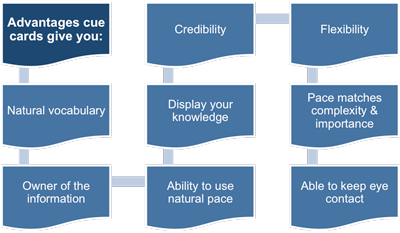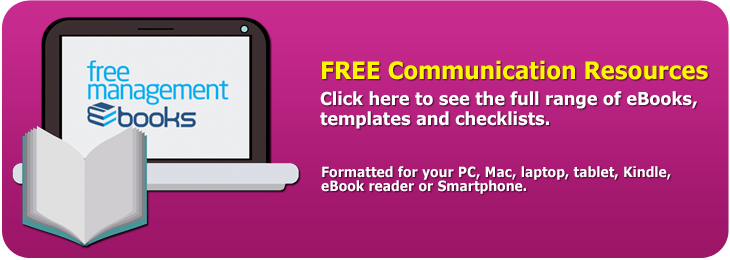Communication Skills - Cue Card Guidelines
To maximize the benefits of cue cards there are several basic guidelines that you should use when creating your own:
1. Clearly number the cue cards
2. Only write on one side
3. One key point per card
4. Each card should contain adequate support and cues
5. Logical levels can be shown by alterations in font size, spacing, color, or highlighting
6. Include timings and pauses.
The first principle is to ensure that a clear and unambiguous numbering convention is applied to all of the cards so that if you drop them you can quickly re-arrange them into the correct sequence.
By only using one side of each card you avoid the distracting behavior of flipping and manipulating cards. It helps prevent you wondering whether or not you have addressed both sides of each card. Clarity is further supported by only communicating one theme or idea on each card.
This way, when you have covered the point you will be confident that you can move on to the next card without having to re-scan the cards, which can be very distracting. It also stops you putting so much detail on the card that you end up reading from it or continually referring to it. This would be distracting and would also reduce your eye contact with the audience.
Cue cards usually evolve during the rehearsal stage and become simpler as you become more familiar with the material. So don't worry if initially they appear to have too much information. You will often find that after two or three rehearsals they are much briefer, with only one or two words where you previously had a sentence.
 |
Use a large font and double-spacing so that the cue cards are easy to read, enabling you to take in the information at a glance. Use color-coding to identify lower-level information that could be dropped if the allocated time is suddenly shortened or you find yourself overrunning. For example, you might use black for all the essential information and red for topics that could be omitted without compromising the integrity of the message.
Many presenters have their own personal shorthand system - for example, a smiley face symbol could be placed at strategic points on your cue cards to remind you to make contact with the audience and smile. This is something you can develop yourself over time.
The effectiveness of your delivery when presenting from a list of points is directly related to the amount of time you devote to preparing and rehearsing. You need to plan sufficient time so that you become familiar with the content and your words flow naturally.
 |
Presenting in this style allows the audience to view you as someone who owns the information and is knowledgeable about it, as opposed to someone who is simply passing on information. Cue cards also enable you to adjust the way you speak with regard to your use of technical terms and jargon to match the level of understanding in the audience.
Cue cards enable you to maintain eye contact with the audience and to speak at a fairly natural pace. Because the words are coming from within you, you will be able to naturally change the way that you put the material across in real time depending on the feedback you receive from the audience. This also means that you will have the opportunity to go over certain key points if you feel that they have not been well understood.
Pace plays an important part in the effectiveness of your delivery. It is usually quite clear when the audience wishes you to speed up or slow down and explain points more fully. You will find that when you come to a difficult point you naturally slow down because the words do not come as easily to you. The audience will respond to this change in pace by concentrating a little harder on what you are saying because they intuitively know this is an important or difficult point they need to understand.
Similarly, when you are covering material that is relatively straightforward, the words come more easily and you speak more quickly. This is perfectly acceptable to the audience because they are not struggling to understand something complicated. Nobody expects you to deliver your presentation at exactly the same pace from start to finish. In fact, the presentation will have much more impact if you change the pace to match the complexity or importance of the points you're putting across.
Allocating sufficient time to rehearse your presentation ensures that you are familiar with the topic so that you don't need exact wording on your cards. This familiarity prevents you from becoming lost for words or interrupting the flow of your presentation, reducing the likelihood that you will become flustered.
You may also be interested in:
Giving a Management Presentation | Styles of Presenting | Developing a Persuasive Delivery Style | How to Rehearse | Reading Your Audience | Retaining Control in a Presentation | Question and Answer Session | Importance of the Presentation Venue | Presentation Venue Layout.



